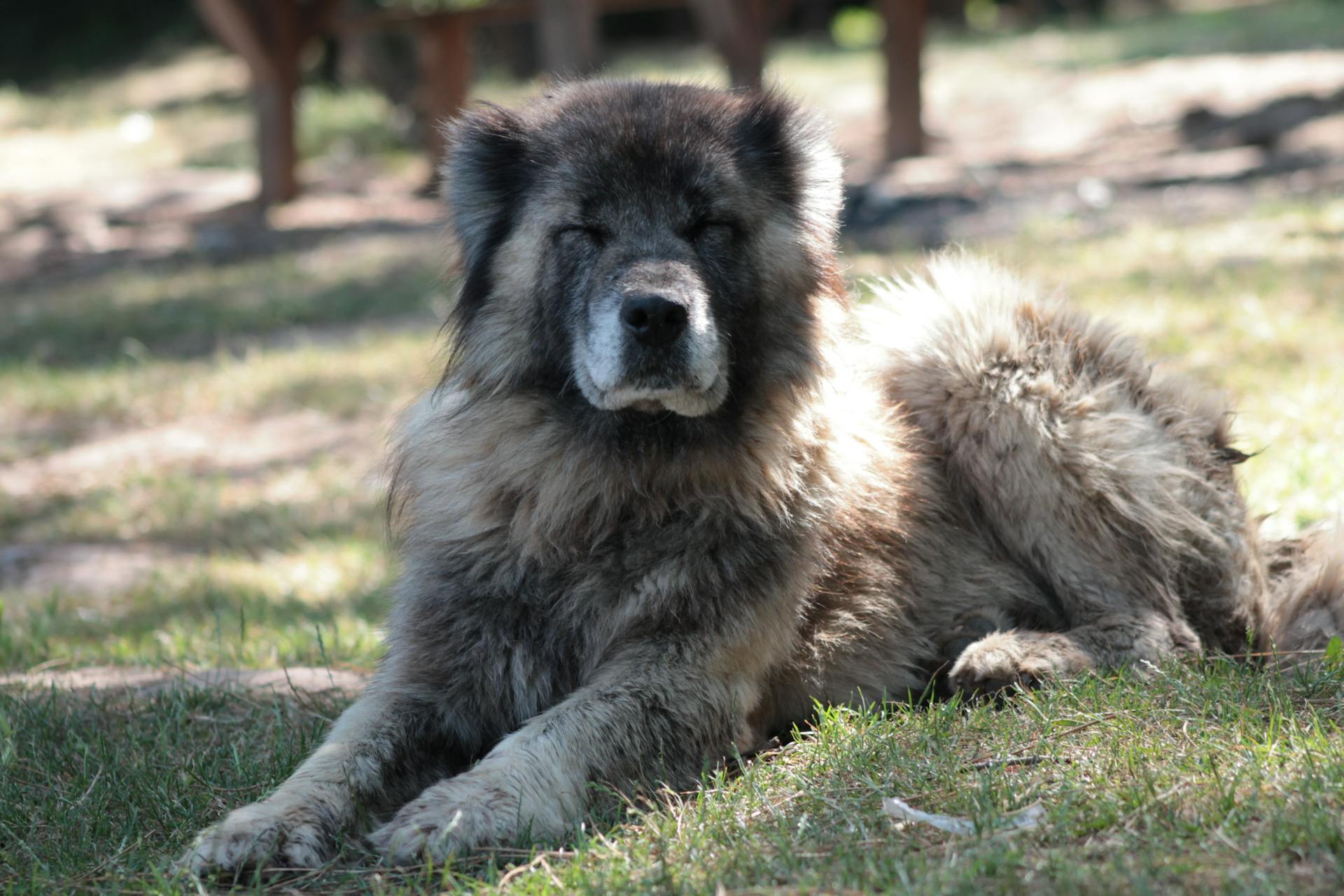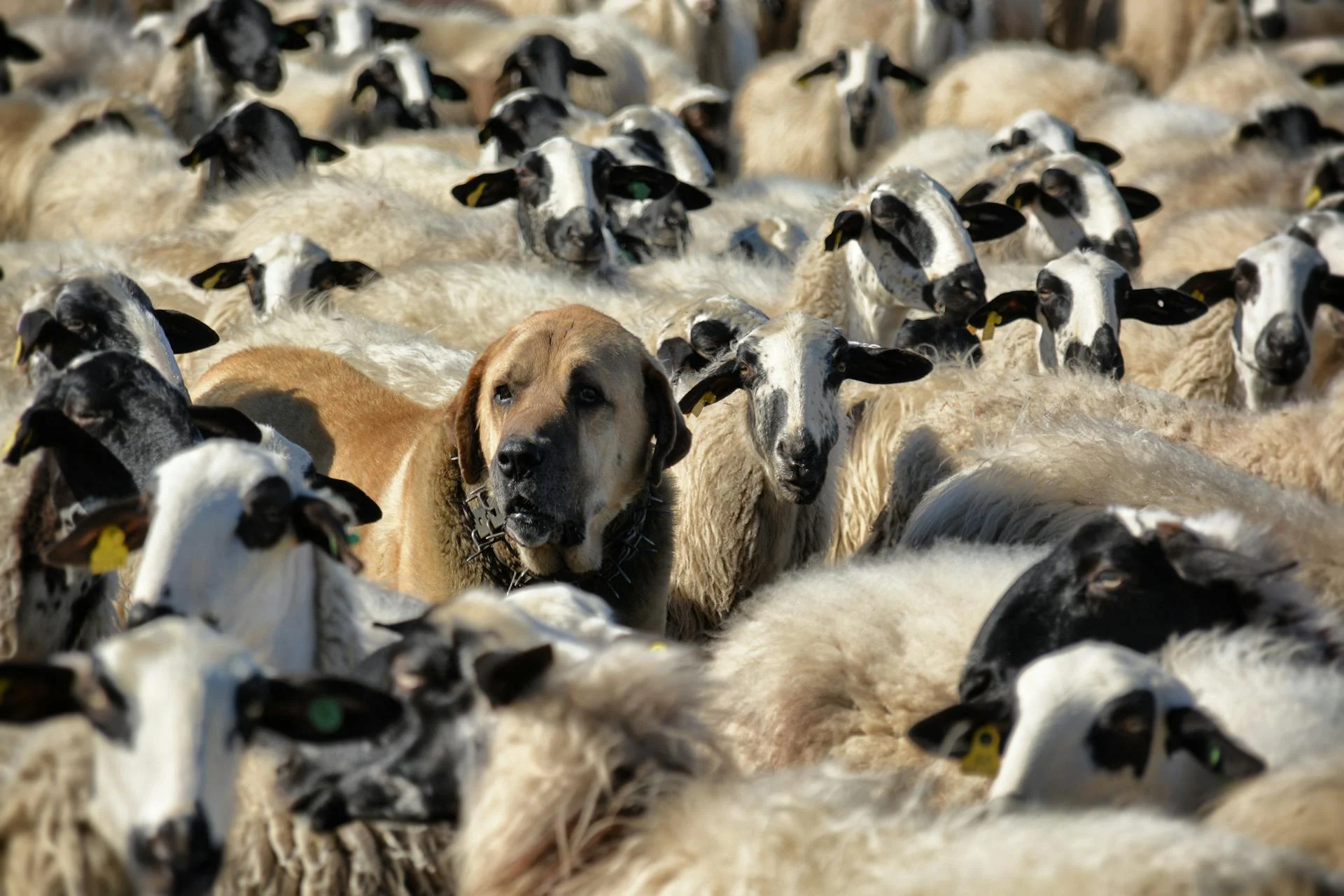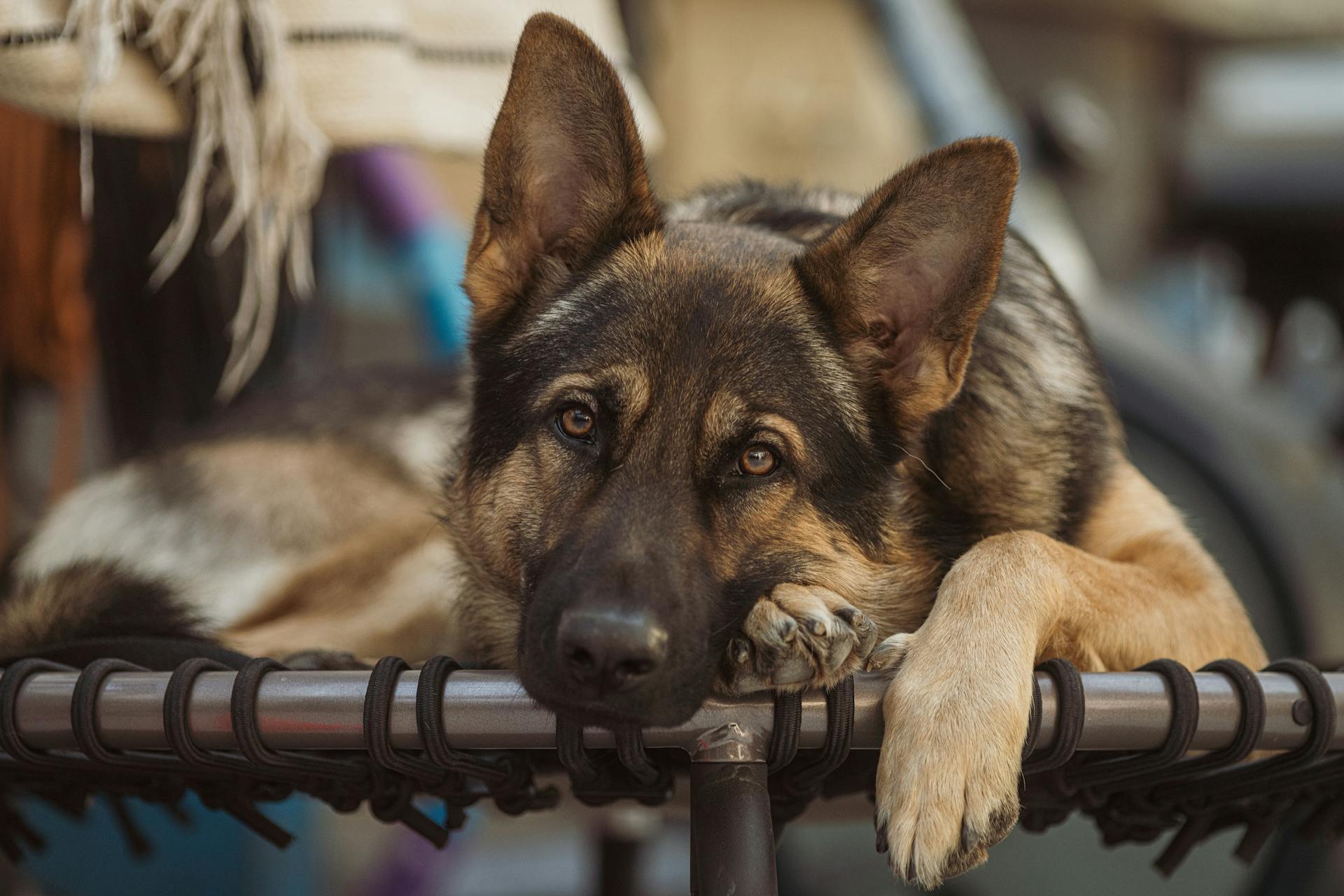
These dogs are naturally protective of their families and territories, so early socialization is crucial to ensure they grow into well-adjusted adult dogs.
They thrive on physical and mental stimulation, requiring daily exercise and engaging activities to keep them happy and healthy.
With proper training and care, they can become loyal and loving companions for active families or individuals.
Personality/Temperament
The Caucasian Mountain Shepherd Dog is a guardian dog that demands respect and attention. They're naturally distrustful of strangers and can be quite territorial, so be prepared for a strong sense of ownership.
These dogs are highly intelligent, but also stubborn, making training a challenge that requires patience and consistency. They need firm boundaries and a dedicated owner who can provide the necessary guidance and socialization.
As a household companion, they're loving and loyal to their family members, but may seem aloof to outsiders. They secretly crave hugs and cuddles, but will only show affection to those they trust.
Early socialization and training are crucial to minimize their natural distrust of strangers and to prevent aggression. Proper socialization can help them become a loving and loyal guardian that's a joy to have around.
With their low energy levels and laid-back nature, they're not high-maintenance dogs, but they do require regular exercise and mental stimulation to prevent boredom and destructive behavior.
Livestock Guardian Lifestyle
The Caucasian Mountain Shepherd Dog, also known as the Caucasian Ovcharka, is a livestock guardian dog that's been used for centuries to protect sheep, goats, and other livestock from predators.
Historically, these dogs were used in Russia to guard large flocks of sheep in mountainous regions during the summer months and would move back down to the plains and villages during the colder months.
They were bred to fight off ferocious wild animals, including wolves, and are one of the few dog breeds that could give wolves a strong fight.
Readers also liked: Border Collies Herding Sheep
The Caucasian Ovcharka is more social than some other livestock guardian breeds, meaning they like to be under the direction of shepherds and work closely alongside them.
They have a strong instinct to protect their flock and territory, which can make them wary of strangers and other animals.
If you're considering adopting a Caucasian Ovcharka, be prepared for a dog that's loyal and protective of its family, but may take time to warm up to new people and animals.
Here are some key characteristics of the Caucasian Ovcharka's livestock guardian lifestyle:
- Originally used to guard sheep, goats, and other livestock
- Bred to fight off predators like wolves, jackals, and bears
- More social than some other livestock guardian breeds
- Strong instinct to protect flock and territory
Overall, the Caucasian Ovcharka is a unique and impressive breed that's well-suited to its role as a livestock guardian dog.
Pet Traits and Care
Caucasian Mountain Shepherd Dogs can make wonderful family pets, but they're not for every household. They're large dogs with independent natures, making them challenging to train for novice owners.
Their size and temperament mean they're not suited for apartment living, and they require regular exercise to stay happy and healthy. Even with lower exercise needs than some other breeds, they still need room to roam.
If you're considering bringing a Caucasian Mountain Shepherd Dog into your family, be prepared for barking, especially at night. They're naturally protective of their family, so it's essential to educate your children on how to interact with them safely.
Here are some essential care tips to keep your Caucasian Mountain Shepherd Dog happy and healthy:
- Brush their teeth 2-3 times a week and clean them professionally as recommended by your vet.
- Check their ears weekly for signs of debris or wax buildup and clean them as needed to prevent ear infections.
- Clip their nails as needed to prevent breaking and injury.
- Keep an eye out for drool and wipe it away when necessary to avoid getting your home covered in slobber.
Pet Traits
The Caucasian Ovcharka is a wonderful breed, but they do come with some unique challenges. They can be quite large and have independent natures, making them difficult to train for novice dog owners.
It's essential to note that these dogs are great with children in the family, but introducing new children should be done with caution. Proper education is key to ensuring the safety of both the children and the dog.
A word of caution: Caucasian Ovcharkas are not suited for apartment living due to their size and exercise needs. They require a spacious environment to thrive.
Barking is another characteristic to be aware of. These dogs have a strong instinct to bark, especially at night, so it's crucial to plan accordingly.
If you're considering owning a Caucasian Ovcharka, it's essential to be aware of their potential aggression towards other animals. Early socialization is key to increasing the likelihood of introducing them to other household pets.
Here are some key traits to keep in mind when considering a Caucasian Ovcharka as a pet:
- Large size and independent nature
- Great with children, but requires caution when introducing new children
- Not suited for apartment living
- Prone to barking, especially at night
- Potential aggression towards other animals
Owning Essentials
Owning a pet comes with its own set of responsibilities, and one of the most important things to consider is the type of care your pet needs. You'll want to discuss diet and exercise with your veterinarian or nutritionist to ensure your pet maintains a healthy weight.
Regular grooming is also essential for your pet's health and happiness. Brushing your Caucasian Shepherd Dog's teeth two to three times a week can help prevent dental problems.
Ear infections can be a real issue if you don't keep an eye on your pet's ears. Check for signs of debris or wax buildup at least once a week and clean as needed.
Clipping your pet's nails regularly can prevent breaking and injury.
Appearance and Grooming
The Caucasian Mountain Shepherd Dog has a unique appearance that's both powerful and rugged. They have a heavily built body with a broad chest and a short, extremely muscled neck.
Their coat comes in various lengths, including short, medium, and long, and is double-coated with a rougher outer coat and a soft, fine undercoat. They also have feathering on their legs and tail, and fur between their toes to keep them protected and insulated.
Their coat color is quite diverse, ranging from gray, fawn, red, cream, tan, and solid white, with possible brindle or patchy patterns. They often have white markings on their body and a dark "mask" around their face.
You'll want to brush their thick coat at least twice a week to remove loose or dead hairs and prevent matting, especially during shedding season. Here are some recommended grooming tools:
- Pin brush
- Comb
- Deshedder
Regular nail trimming, ear cleaning, and dental care are also essential to keep your Caucasian Mountain Shepherd Dog healthy and happy.
Appearance and Grooming
The Caucasian Ovcharka is a majestic breed, known for its powerful build and distinctive appearance. They have heavy muscular bodies and thick coats that protect them from harsh environments.
Their coat can vary in length, from short to long, and is double-coated with a rough outer coat and a soft undercoat. They often have a pronounced mane around their necks and feathering on their hind legs and tails. Regular brushing is essential to prevent matting and tangling, especially during their heavy shed once a year.
A pin brush, comb, and deshedder are must-haves for maintaining their coat. They also require regular nail trimming, ear cleaning, and dental care to prevent painful health issues. Daily brushing is recommended for dogs with long hair, while weekly brushing is sufficient for those with shorter coats.
Here's a quick rundown of their grooming needs:
* Brushing frequency:
+ Short coats: weekly
+ Long coats: daily
- Nail trimming: regular
- Ear cleaning: regular
- Dental care: brush teeth every few days
Their thick coat and large size make them prone to obesity, so it's essential to monitor their weight and diet carefully. Regular exercise and a balanced diet will help keep them healthy and active.
Tail
The Caucasian Ovcharka has a distinctive tail that's typically curled over the back in a hook-shape when excited.
Their tails should not be cropped, so it's essential to respect their natural appearance.
The way their tail hangs naturally downward when at ease is a great indicator of their overall temperament and comfort level.
Broaden your view: When Is It Best to Breed a Female Dog
Health and Nutrition
The Caucasian Mountain Shepherd Dog is a robust breed, but like all dogs, they can be prone to certain health concerns. Hip dysplasia and elbow dysplasia are common problems in large breeds like the Caucasian Mountain Shepherd Dog, which can lead to joint instability and arthritis.
They are also at risk for bloat, a life-threatening condition where the stomach fills with gas and twists on itself. Obesity is another issue, as these dogs can easily put on weight if their diet and exercise aren't properly managed.
A well-balanced dog food is essential for their health and nutrition. For large breed dogs, it's recommended to feed them puppy food designed specifically for their rapid growth and development. As they mature, they can be transitioned to adult food.
Readers also liked: Large Mountain Dogs
The caloric intake of Caucasian Mountain Shepherd Dogs will greatly depend on their size and activity level. Males require anywhere from 2445 to 6515 calories per day, while females need between 2275 and 5930 calories per day. Here's a rough estimate of their daily caloric needs:
To avoid obesity, it's essential to feed them frequently, but in smaller amounts. Two to three meals a day are recommended, and owners should consult a veterinarian and a dog nutritionist to formulate the right kind of food for their dog. Regular exercise and monitoring their weight are also crucial to maintaining their health.
Exercise
Caucasian Mountain Shepherds are happiest and healthiest in homes with a yard for them to be active in.
They do well with families that stay active and will take them for their daily walks.
It's essential to keep them leashed when on outings with them.
Their stamina is good enough for walking and hiking, despite being low energy compared to other large breeds.
Cost and Rescue
The cost of a Caucasian Mountain Shepherd Dog can vary greatly, with prices ranging from $1500 to $2000 on average in the United States.
However, if you're looking for a dog from guaranteed pure blood lines, be prepared for a significant investment, as these dogs can be quite difficult to obtain.
If you're set on adopting a Caucasian Mountain Shepherd Dog, consider reaching out to Caucasian Ovcharka Rescue Rehome USA on Facebook, as they specialize in finding homes for the breed.
Cost
The cost of a Caucasian Ovcharka can vary significantly. In the United States, the average price is between $1500 and $2000.
If you're looking for a true livestock guardian breed with guaranteed pure blood lines, be prepared for a higher price tag. These dogs can be quite expensive and difficult to obtain, especially if you're looking to import one.
Their price range is influenced by their breeding history and authenticity.
For more insights, see: How Much Is a Pug Dog
Rescue Groups
If you're interested in adopting a Caucasian Shepherd Dog, you may want to consider reaching out to a reputable rescue group.
Caucasian Shepherd Dog Rescue Groups, such as Caucasian Ovcharka Rescue Rehome USA on Facebook, specialize in finding homes for the breed.
History and Origins
The Caucasian Shepherd Dog has a rich history that spans over 2,000 years, originating from the Caucasus Mountain region. They hail from a mysterious past, with some believing they came from wolves that were domesticated, while others think their ancestry includes Mastiffs and other breeds.
The breed was developed to be fearless, strong, and intimidating, with a dense and water-resistant coat that allowed them to survive in harsh climates. Shepherds bred these qualities into their dogs, which were used to safeguard and herd flocks and livestock.
The Caucasus Mountain region is vast, resulting in many different variants of the breed emerging, with the Caucasian Shepherd Dogs developed in Georgia becoming the breed standard recognized by most kennel clubs today.
Breed Information
The Caucasian Ovcharka is a breed that originated in Russia.
They are traditionally used to guard sheep and goats.
This breed is quite large, weighing between 99 and 170 pounds.
They are suitable for experienced dog owners or active families with older children.
Their personality is a mix of stubborn, independent, friendly, and loving traits, but they can also be aggressive towards strangers.
Central Asian
The Central Asian Shepherd is a breed that shares ancestors with the Caucasian Ovcharka and comes from similar geographical areas. It's often considered a separate breed due to its distinct characteristics.
This breed was used by nomads and has a higher tendency to roam. They were also used as both livestock guardians and home watchdogs.
In the 1960s, East Germany used the Central Asian Shepherd's close relative, the Caucasian Shepherd Dog, as border patrol dogs along the Berlin Wall. After the wall's collapse in 1989, thousands of these dogs were given to German families.
Curious to learn more? Check out: Central Asian Ovcharka Dog

The Central Asian Shepherd tends to be calmer in demeanor and more people-oriented in general compared to the Caucasian Ovcharka. They are often used by nomads due to their ability to roam.
Both the Central Asian Shepherd and the Caucasian Ovcharka are livestock guardian breeds that were used to protect flocks of sheep from predators like wolves, jackals, and bears.
Intriguing read: Alabai Dog Lifespan
Quick Facts
The Caucasian Mountain Shepherd Dog is a magnificent breed with a rich history and unique characteristics. They originated in the Caucasus Mountains between Europe and Asia.
Male Caucasian Mountain Shepherd Dogs typically stand between 27.5-30 inches tall at the shoulder and weigh between 110-154 pounds. Females are slightly smaller, standing between 26.5-29 inches tall and weighing between 90-110 pounds.
This breed is part of the working group, which means they were originally bred for a specific job. In this case, they were used to help shepherds protect their flocks from predators like wolves and bears.
Caucasian Mountain Shepherd Dogs have a long, thick double coat that can be straight or curly. Their lifespan is relatively short, ranging from 10-12 years.
They require high exercise and consistent training to reach their full potential. Early socialization is crucial to ensure they grow into well-behaved adults.
Here's a summary of their size and weight:
They can make excellent family companions, but they do require a lot of attention and care. With proper training and socialization, they can thrive in a variety of environments.
Frequently Asked Questions
Are Caucasian mountain dogs legal in the US?
Caucasian mountain dogs are generally legal in the US, but local laws may vary, so check your community's regulations before bringing one home.
Is a Caucasian Shepherd a good family dog?
Yes, a Caucasian Shepherd can make a great family dog, but they require a strong, experienced owner who can provide the necessary training and care. With proper attention, they are loving, devoted, and gentle with their family.
Are Caucasian shepherds friendly to strangers?
Caucasian Shepherds are generally aloof with strangers and may take time to trust new people. They require an experienced owner to help them feel secure in new situations.
How big do Caucasian mountain shepherds get?
Caucasian Shepherds typically weigh between 100-170 pounds and stand 23-30 inches tall. They require ample space due to their large size.
Do Caucasian Ovcharka make good pets?
Caucasian Ovcharkas can be loving family pets, but they require experienced owners and a suitable living situation. They are not recommended for apartment living or homes with small children due to their strong will and assertive nature.
Sources
- https://www.forloveoflivestock.com/blog/caucasian-ovcharka-livestock-guardian-dog-breed
- https://www.dogster.com/dog-breeds/caucasian-ovcharka
- https://www.realesaletter.com/blog/dog-breeds/caucasian-shepherd-dog
- https://dogtime.com/dog-breeds/caucasian-shepherd-dog
- https://www.asguardkennels.com/the-caucasian-shepherd/
Featured Images: pexels.com

